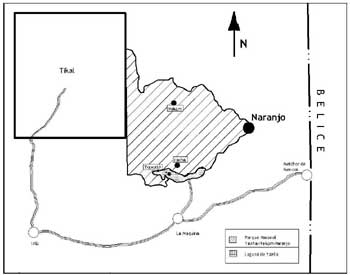
| FAMSI © 2009: Vilma Fialko |
||
The Map of the Southwest Periphery of Naranjo, Petén, Guatemala
Research Year: 2006 Table of Contents
The settlement of the residential periphery of the southwest zone of Naranjo, Petén
Background Naranjo is located within the Yaxhá-Nakum-Naranjo National Park, a mere 10 km from the border between Guatemala and Belize. Because of its location, this important site has been the object of ongoing predation, and the looted objects have been easily trafficked through the border (Figure 1).
Throughout 2002-2004 thanks to the archaeological rescue program sponsored by IDAEH with support from Germany, it was possible to record 74 tunnels and trenches, which amount to 28% of the existing damages in Naranjo's monumental epicenter (Fialko et al. 2002, 2003, 2004). Although we considered the possibility of extending the study of diagnosis and rescue toward the rest of the epicenter and part of the periphery, this goal was not possible because the Ministry of Culture and Sports did not have the necessary resources. In light of this situation, in order to avoid the collapse of major tunnels and trenches which were not evaluated, we thought it would be convenient to provisionally close them down. We planted a particular kind of vegetation on the surface in order to have a clear reference for future identification and location. Starting in 2005 the Project of Archaeological Research and Rescue in Naranjo (PIAREN) was organized. Thanks to several financial contributions this project has been able to carry on with the rescue process both in the epicenter and in the periphery. One of the first initiatives of the PIAREN project was to seek support from the World Monuments Fund, which responded favorably in 2005 by including Naranjo in the list of the 100 sites in most urgent need for rescue and conservation worldwide. Afterwards the PIAREN project started the study of two of the 12 tunnels found in the Central Acropolis, with Famsi's assistance and the participation of volunteer archaeologists, as well as the Department of Prehispanic Monuments, and workers provided by the General Directorate of Cultural and Natural Heritage (Fialko 2005). Likewise, the first surveys were conducted in the residential compounds located in the north and south peripheries. An immediate outcome of this was the confirmation of the huge degree of looting and damage to structures in virtually all plaza groups identified in the vast residential periphery. In the current field season of 2006 we still had the logistical facilities and camp provided by Guatemala's Institute of Anthropology and History and the Yaxhá-Nakum-Naranjo National Park. We also had the participation of graduate students Cyril Giorgi (Sorbonne University, France), Alexander Tokovinine (Harvard University), as well as Guatemalan archaeologists Adriana Segura and Rafael Cambranes, who were assigned by the Department of Prehispanic and Colonial Monuments (IDAEH) to support the survey and mapping process. The IDAEH also contributed ten field workers who were trained for conducting survey and mapping work in Naranjo. Click to download the report in PDF format: The Map of the Southwest Periphery of Naranjo, Petén, Guatemala (3.73 MB) The PDF files require Adobe Acrobat Reader.
Submitted 07/10/2007 by: |
||
|
Text links to all pages at this site are available at the FAMSI INDEX |
||


